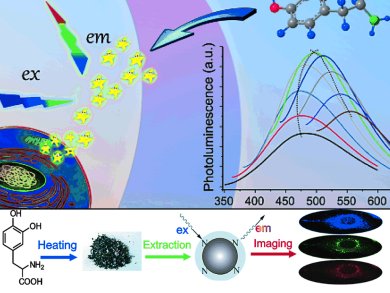Carbon dots (Cdots) have attracted considerable attention because they are an important probe for imaging and sensing applications. This is due to their fluorescence properties, good biocompatibility, and low toxicity, which are advantages over heavy-metal-based quantum dots and the dye-based fluorescence probes used for imaging and sensing.
Cdots consist of carbon, hydrogen, and oxygen with a quasi-spherical structure in which the carbon shows the character of crystalline graphite. Unfortunately, complex procedures and strong acid treatment are often required for the formation of Cdots. Although Cdots suffer from low photoluminescence (PL) emission, heteroatom doping enhances their emission by inducing an upward shift of the Fermi level and electrons in the conduction band.
Xue-Bo Yin and co-workers, Nankai University, China, propose a facile and general carbonization and extraction procedure to prepare a series of N-doped Cdots (N-Cdots) with different nitrogen contents, a low oxidation level, and multicolor emission. The intensities of the multicolor emission from the N-Cdots were confirmed to be nitrogen-content-dependent, whereas the emission-peak wavelength was Cdot-size-dependent. Furthermore, multicolor photoluminescence was confirmed in living cell systems.
Because this synthetic method allows Cdots with various nitrogen contents to be prepared by using different precursors, these results suggest the possibility of preparing doped Cdots with special and tunable PL properties.
- Nitrogen-Doped Carbon Dots: A Facile and General Preparation Method, Photoluminescence Investigation, and Imaging Applications,
Y. Xu, M. Wu, Y. Liu, X.-Z. Feng, X.-B. Yin, X.-W. He, Y.-K. Zhang,
Chem. Eur. J. 2013, 19(7), 2276–2283.
DOI: 10.1002/chem.201203641





a novel insight into carbon dot optical properties